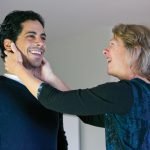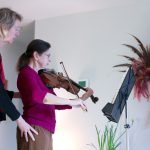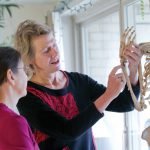+ By Leah Weiss + Photos by Amy Raab
Imagine finding out that you must relearn how to move—and you’re a dancer. That happened to Robin Gilmore. Schooled in ballet, Gilmore was passionately pursuing a modern dance career at American University in Washington, DC, practicing for hours every day. Then she started getting injured.
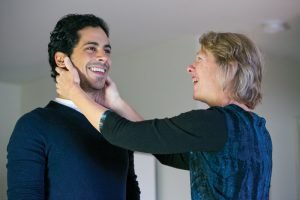 Her back would go into such intense spasms that she could not move. Gilmore thought that if she only tried harder, the problem would go away. But the injury kept recurring. A professor told her that if she didn’t stop what she was doing and study the Alexander Technique, she wasn’t going to make it.
Her back would go into such intense spasms that she could not move. Gilmore thought that if she only tried harder, the problem would go away. But the injury kept recurring. A professor told her that if she didn’t stop what she was doing and study the Alexander Technique, she wasn’t going to make it.
What followed was life changing. “I was basically feeling like I was going to fall over in class because my old habits were to try so hard,” she says. “In Alexander Technique, it’s about doing less, and so I really felt like I was starting over. But I knew that this mattered.”
After six months of weekly lessons, Gilmore’s back issues began to resolve, and her dancing took off. “I was soaring. I was doing things I’d never been able to do, with less effort. That’s when I was hooked.”
Alexander Technique is a method of self-learning used by many performers to release muscular tension, move with ease, and heal and prevent injury. Sting, Paul McCartney, Yehudi Menuhin, Julie Andrews, and Ben Kingsley are among the luminaries who have studied it. College performing arts programs from The Juilliard School to the University of Maryland routinely offer Alexander Technique classes to students.
 In the late 1800s, Frederick Matthias Alexander, a Tasmanian actor living in London and performing Shakespeare, started losing his voice during performance. Over years of self-observation and exploration, he realized that his hoarseness came from a habit of tension and pushing. Importantly, he viewed the problem and its solution as not isolated to the neck and head area but involving the full body, including the mind. “As soon as he would think about speaking,” explains Gilmore, “his habit had already kicked in, before he even uttered a word.” Simply put, our thinking enervates our moment.
In the late 1800s, Frederick Matthias Alexander, a Tasmanian actor living in London and performing Shakespeare, started losing his voice during performance. Over years of self-observation and exploration, he realized that his hoarseness came from a habit of tension and pushing. Importantly, he viewed the problem and its solution as not isolated to the neck and head area but involving the full body, including the mind. “As soon as he would think about speaking,” explains Gilmore, “his habit had already kicked in, before he even uttered a word.” Simply put, our thinking enervates our moment.
Alexander Technique is paying attention with all of the senses, including the kinesthetic (movement) sense. “It’s a way to learn about yourself in activity and where you might be working against yourself, in some cases actually harming yourself, through habitual misuse and miscoordination,” says Gilmore. She works with students (who are not considered clients—they are learning) through a combination of gentle touch, movement, and discussion. “The way to change falls on the self, and changing—on a very subtle yet fundamental way—how you are walking through the world. It’s really about embodied awareness.”
Gilmore knew early on that she wanted to teach the Alexander Technique. While living in Amsterdam after college, she was directed to a teacher-training program in Philadelphia. Alexander Technique International’s rigorous credentialing process, requiring a minimum of three years of study before starting to teach, did not faze her. She became certified in 1986, studying with several teachers who had learned directly from Mr. Alexander. After earning a Master of Fine Arts degree in dance and choreography from Temple University, Gilmore divided her time between the United States and Japan and established an Alexander Technique teacher-training program in Kyoto.
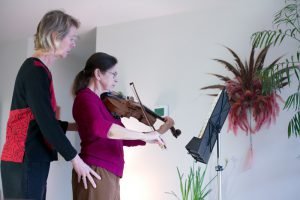 In 2001, Gilmore moved to Annapolis and opened Chesapeake Bay Alexander Studies, offering private lessons, introductory and custom-designed classes, and residential workshops across the eastern United States and beyond. She created and directs a teacher-training program in Greensboro, North Carolina, and gives workshops such as “Save Your Spine” in Annapolis a few times every year. In early April, she’ll teach “Freedom to Breathe,” an exploration of the structures and movement of breath, at Ridgely Retreat.
In 2001, Gilmore moved to Annapolis and opened Chesapeake Bay Alexander Studies, offering private lessons, introductory and custom-designed classes, and residential workshops across the eastern United States and beyond. She created and directs a teacher-training program in Greensboro, North Carolina, and gives workshops such as “Save Your Spine” in Annapolis a few times every year. In early April, she’ll teach “Freedom to Breathe,” an exploration of the structures and movement of breath, at Ridgely Retreat.
She also employs “Body Mapping,” a technique she learned from musician and mentor Bill Conable, in her work. “You can know all the anatomy in the world, but when it comes to your own body, you have these misconceptions,” she says, giving the example of ballet dancers who appear two-dimensional: “When you’re staring at yourself in the mirror in class, that becomes a bad habit.” Body maps can come from a number of places, but they are unconscious. “When you bring it to the level of consciousness and figure out the reality, you can correct the body map.” Gilmore authored What Every Dancer Needs to Know About the Body (GIA Publications, Inc., 2005), a workbook of body mapping and the Alexander Technique.
No longer dancing professionally, Gilmore remains active in the Washington, DC, dance community. She often performs at Alexander Technique conferences and international congresses, collaborating with vocalists and instrumentalists. “I’m just a mover,” she grins.
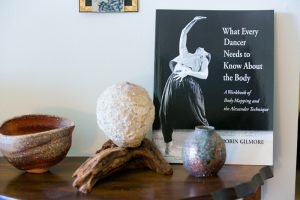 Gilmore enjoys the diversity of her students, many of whom are performing artists and equestrians. “I love to do barn calls after studio work,” she laughs. “Whatever is happening in the rider’s coordination is transmitted to the horse,” she elucidates, “so if a rider is tense and fearful, it’s conveyed to the horse.” With the current technology revolution changing how we use our bodies—sitting for much of the day with electronic devices, prone to “text neck” and trigger finger—Gilmore expects more non-performers to walk through her door.
Gilmore enjoys the diversity of her students, many of whom are performing artists and equestrians. “I love to do barn calls after studio work,” she laughs. “Whatever is happening in the rider’s coordination is transmitted to the horse,” she elucidates, “so if a rider is tense and fearful, it’s conveyed to the horse.” With the current technology revolution changing how we use our bodies—sitting for much of the day with electronic devices, prone to “text neck” and trigger finger—Gilmore expects more non-performers to walk through her door.
A memorable teaching moment transpired in Japan. While Gilmore was doing some hands-on work, her student looked up and down and then started crying. After a moment, the student spoke, and the translator translated, “I meet myself for the first time.” Gilmore immediately, gratefully, understood; she had assisted in changing someone’s sense of self. █


